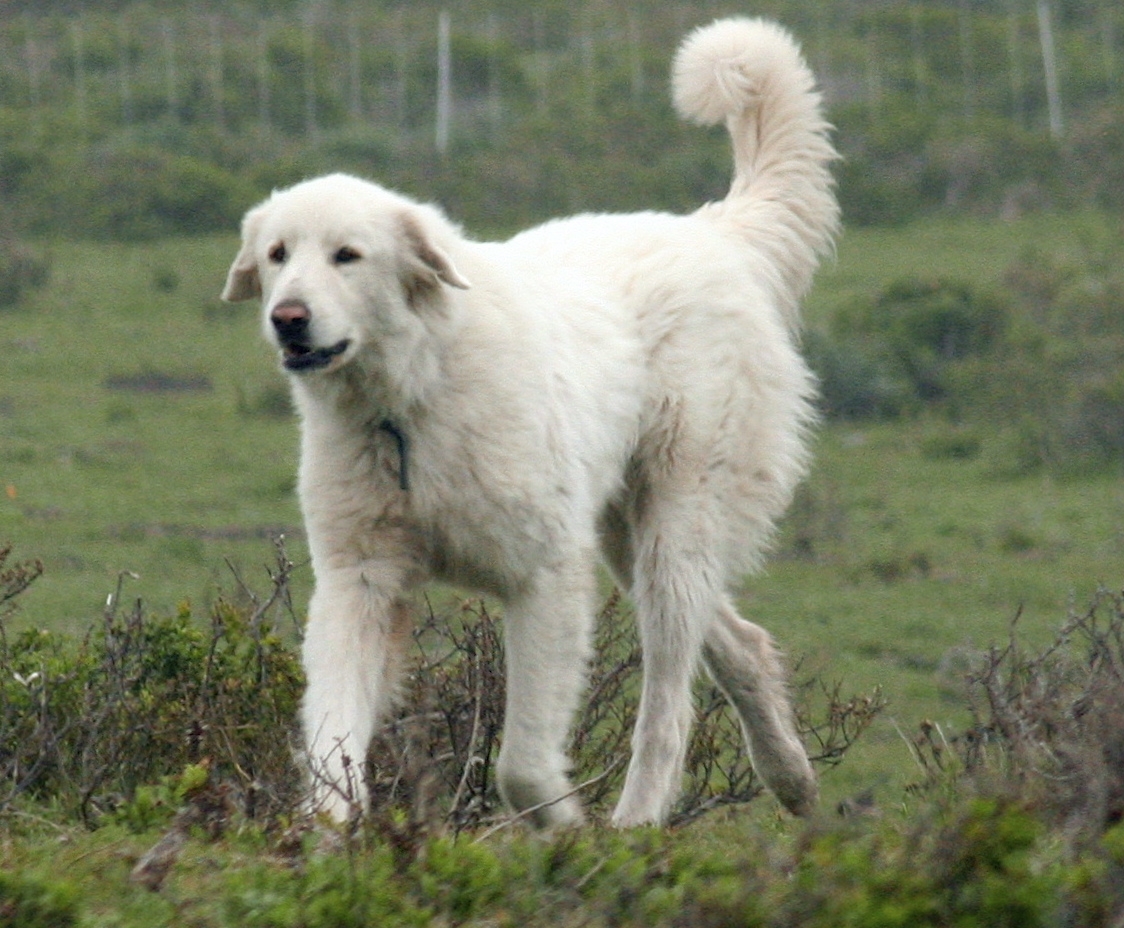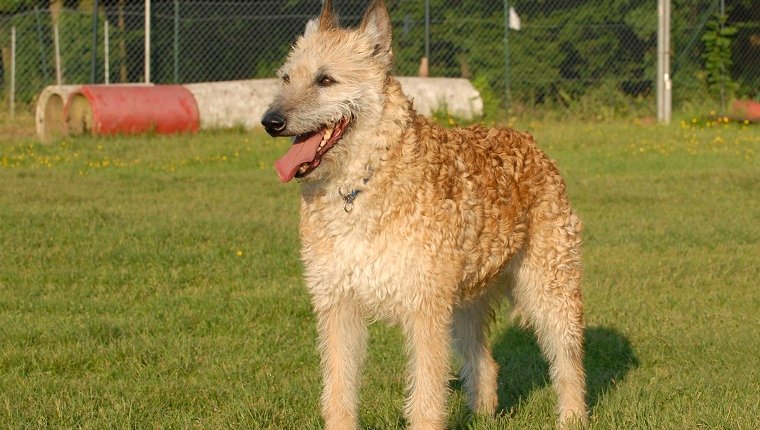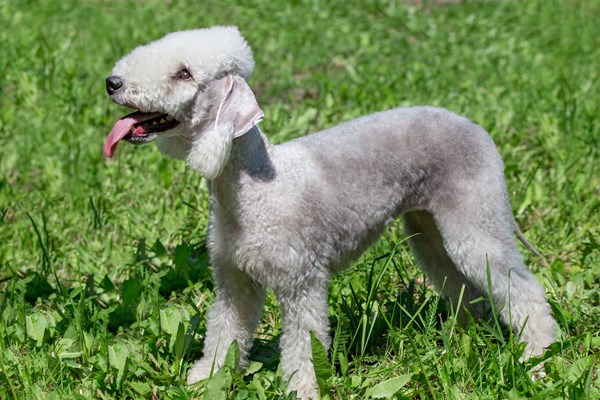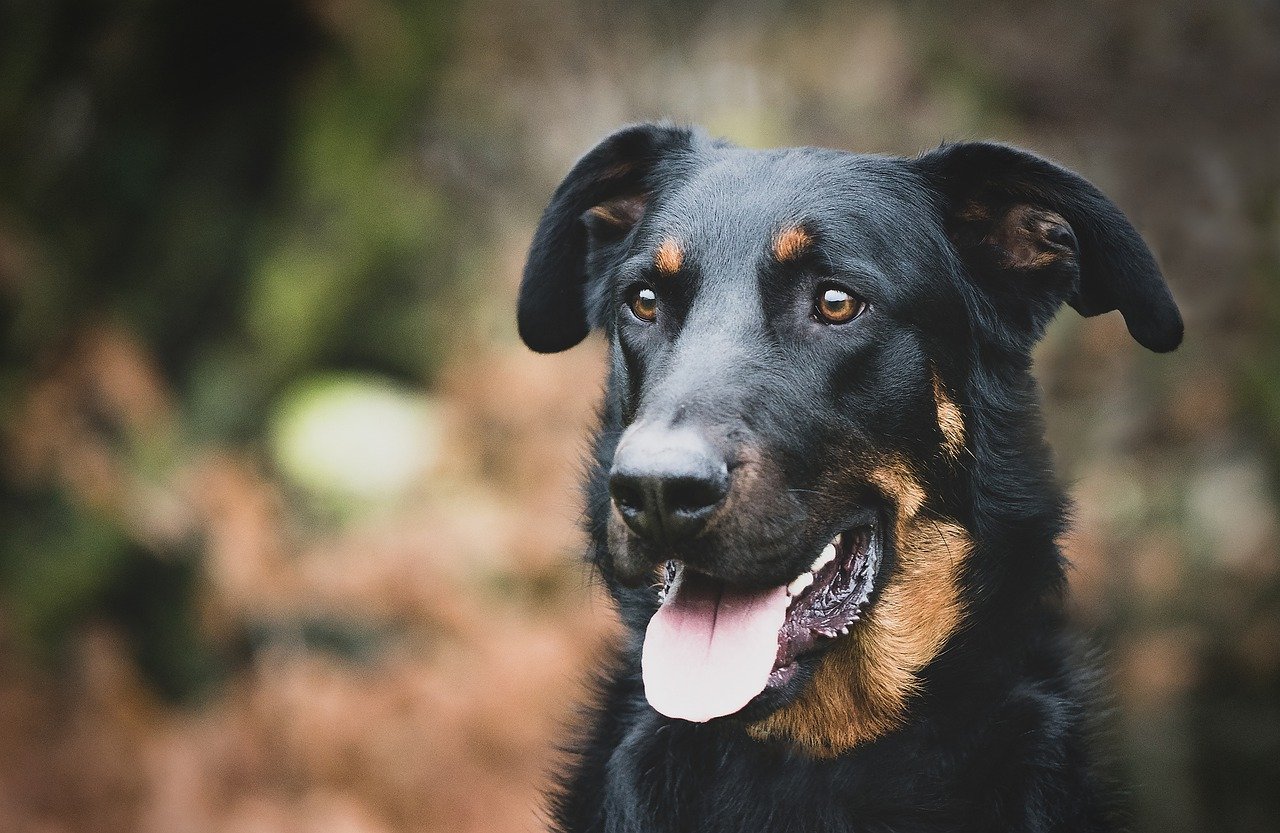The Akbash Dog Overview
Akbash Dogs qualities, which are a unique combination of Mastiff and gazehound attributes, allow him to operate as a livestock guardian.
This all-white, slim, lanky, muscular dog has an alert, royal aspect that conveys power, strength, and courage, as well as the speed and agility required to engage and pursue predators.
When moving or enthusiastic, his wedge-shaped head is ornamented with pendant ears, and his long tail curls over his back.
The Akbash Dog, like other gazehounds, has long legs, a deep chest, and a tucked flank; the breed’s Mastiff influence may be seen in his height, weight, large head, and powerful demeanor.
Akbash Highlights
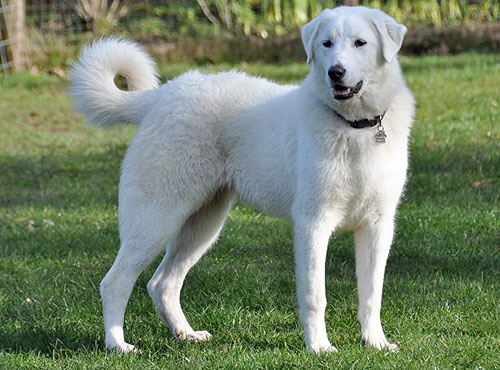
- Akbash coats are exclusively available in white. These canines were developed to defend animals and lambs, and their white coats helped them blend in.
- They shed moderately all year and more heavily in the summer, so brushing once or twice a week will help remove debris and old hair. If you keep up with their needs, the coat can be pretty straightforward to groom.
- Akbashes will growl or snarl at strangers if they suspect anything is wrong, but they are not hostile towards them. The Akbash is an excellent choice for a watchdog and guardian who will alert you to anyone who approaches your door.
- Akbashes are self-sufficient, they rarely experience separation anxiety from their human counterparts. Make sure to give them some space because they prefer to be alone every now and again.
- Akbashes are prone to gaining weight, owing to their low energy levels. Ensure that your dog receives at least one decent half-hour to hour-long walk every day, with a couple nice, energetic play sessions and shorter walks thrown in for good measure.
- Although Akbashes can be socialized, they are not naturally fond of other animals and may prefer to be the only pet in the home.
- Akbash is a huge dog so it can readily withstand overly exuberant children’s play. However, because they are low-energy dogs, they may prefer to be around adults or older children who know how to play gently.
Akbash Breed Features & Ratings:
Rated base on a 5 Star Scale
ENERGY LEVEL: 2 Star
EXERCISE REQUIREMENTS: 2 Star
PLAYFULNESS: 2 Star
AFFECTION LEVEL: 3 Star
FRIENDLINESS TO DOGS: 1 Star
FRIENDLINESS TO OTHER PETS: 3 Star
FRIENDLINESS TO STRANGERS: 2 Star
WATCHFULNESS: 5 Star
EASE OF TRAINING: 2 Star
GROOMING REQUIREMENTS: 3 Star
HEAT SENSITIVITY: 2 Star
VOCALITY 4 Star
Akbash Characteristics:
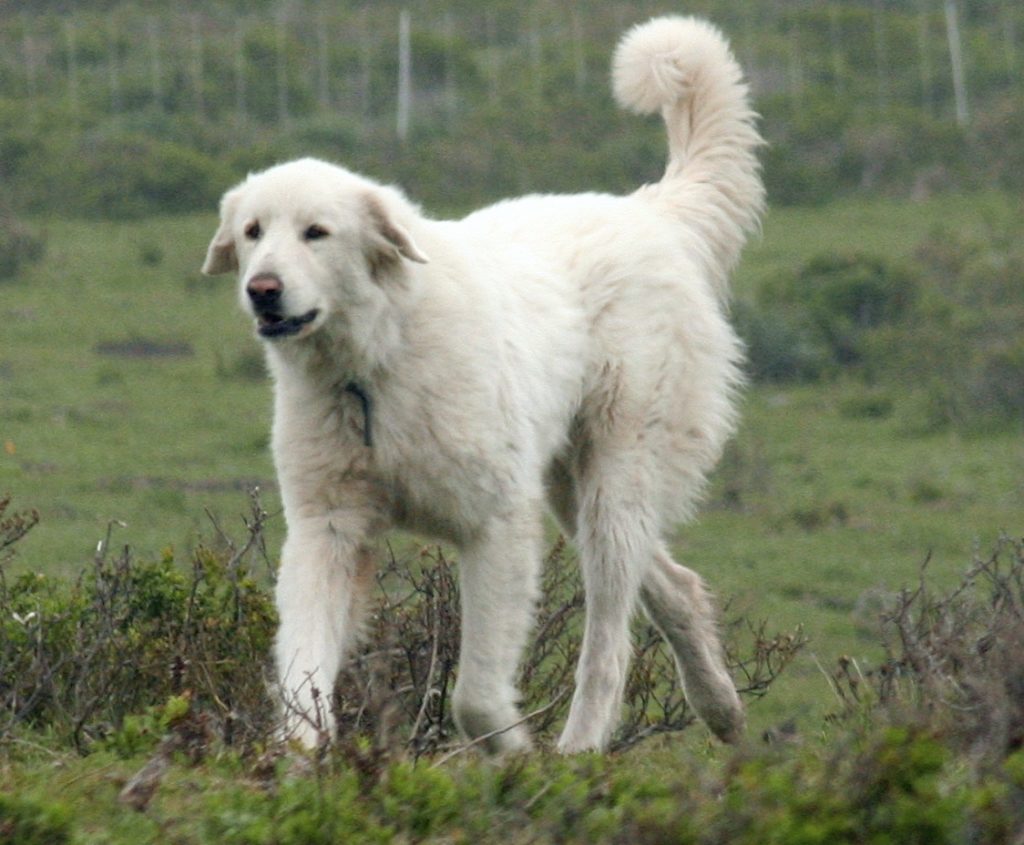
- Dog Breed Group: Working Dogs
- Height: 27 to 34 inches
- Weight: 75 to 140 pounds
- Life Span: 10 to 12 years
- Type: Purebred
- AREA OF ORIGIN: Turkey
- DATE OF ORIGIN: N/A
- OTHER NAMES: Akbash, Akbaş Çoban Köpeği, Coban Kopegi
- Temperament: Affectionate, Alert, Courageous, Independent, Intelligent, Loyal
- Activities: Livestock Guard
- Color: White
- Litter Size: 6 to 8 puppies
- Puppy Prices: Average $700 – $900 USD
Akbash Health:
Every dog has the potential to acquire genetic health problems, just as every person has the ability to inherit a certain disease.
Run, walk away from any breeder who does not offer a health guarantee on puppies, who claims that the breed is 100% healthy and has no known problems, or who claims that her puppies are separated from the rest of the household for health reasons.
Orthopedic difficulties such as hip dysplasia, epilepsy, a cardiac condition known as dilated cardiomyopathy, and a common hormonal disorder known as hypothyroidism are all possible health problems in the Akbash.
Gastric torsion and umbilical hernias are also possible in this breed.
Many of these conditions can be checked for, but not all of them. Do not buy a puppy from a breeder who cannot give you written proof that the parents were cleared of health issues affecting the breed.
Insist on proof that a puppy’s parents have OFA or PennHIP clearances for hip dysplasia, as well as OFA heart and thyroid clearances. Having the dogs “vetted” is not a replacement for genetic health testing.
Akbash Grooming:
Akbash coats are exclusively available in white. These adorable puppies were trained to defend animals and lambs, and their white coats help them blend in.
There are no additional colors acceptable in the pure Akbash breed. The Akbash has a double coat that is medium in length.
They shed moderately, so brushing them once or twice a week can help remove dirt and old hair. If you keep up with their needs every week, the coat can be pretty straightforward to groom.
The Akbash is not well suited to harsh weather because of their longer coats. During the summer, they shed a lot.
If you are taking them somewhere with extreme weather, make sure to plan adequately.
Akbash Exercise:
The Akbash is an outdoor dog who enjoys playing in the yard. However, this does not imply that this breed prefers physical activity.
In fact, the Akbash is noted for having a low energy level. You might have to persuade it to go for a daily walk.
Make it a point to get out for at least 30 minutes every day. Walking is all that is required of the breed; no running or other forms of exercise are required.
Akbash Training:
Training is essential for the Akbash breed and its family. To gain command of the breed, an authoritative leader is required.
This does not imply that you must be physically aggressive or employ unpleasant training methods, but you must be assertive and in command.
You must know what you want, how you intend to get it, and maintain your confidence throughout training. If the Akbash perceives you are not totally in control, it may begin to disregard your instruction.
Socialization should be regarded as part of training as well, and it should begin while your dog is only a few months old.
Because this breed is notorious for being fearful and potentially aggressive towards strangers, early socialization should focus on exposing your dog to new and unusual circumstances and individuals.
This not only introduces the dog to people, but it also teaches him how to act when confronted with something unfamiliar for the first time.
Akbash Food and Nutrition:
Akbash puppies should be fed a meal designed specifically for large breed puppies.
This will help their long bones grow and develop at the right rate, preventing panosteitis, sometimes known as “growing pains.”
As an adult, an Akbash will thrive on most high-quality commercial dog foods. Because of their modest energy requirements, they may require less food in a day than you might assume.
Sticking to a regular feeding plan, in which meals are given at particular times of the day and food is not left out for your dog to consume at his/her leisure, as well as limiting the quantity of treats given each day, can help keep the extra pounds off your Akbash.
If you observe that your dog is still gaining weight, talk to your vet about changing his or her food schedule.
They may advise you on what foods to feed your akbash, how much to feed, and how to help your akbash lose weight.
Akbash Temperament and Personality:
The Akbash is a gentle dog who guards its family fiercely. They are self-sufficient and like having their own space from time to time.
They were developed to protect herds of sheep and still have strong guard instincts today.
These puppies are incredibly intelligent and, while they lack explosive energy, they are quite agile and strong if they detect danger and must act.
If these canines suspect anything is wrong, they will growl or snarl at outsiders, but they are not hostile towards them.
The Akbash is an excellent choice for a watchdog and guardian who will alert you to anyone who approaches your door.
This dog requires a strong and consistent owner who is also sensitive to their training demands. They are easily trainable, but make sure to socialize them with other dogs or pets who may dwell in the house early on.
Because they are self-sufficient, they rarely experience separation anxiety from their human counterparts. Make sure to give these canines some space because they prefer to be alone every now and again.
Akbash Care/Upkeep:
The Akbash was initially developed to be a guard dog rather than a herding dog so they do not require a lot of activity.
These canines were not intended to herd sheep but rather sit on a hillside and watch them.
However, because of their low energy requirements, they are prone to weight gain; therefore, taking your Akbash for a 30 – 60 minute walk at least once a day is still recommended.
Because of their modest energy requirements, they may be less motivated to play endlessly with lively children.
The Akbash was bred with a double coat to keep them warm while they watched over their flocks.
Brushing your Akbash at least once or twice a week is suggested, even if it has a shorter coat. Brushing will aid in the removal of dirt and debris, as well as loose fur, from their undercoat.
Expect your Akbash to shed, especially in the hot months when they are blowing their winter coat. Brushing more frequently during heavy shed months can help keep your home as fur-free as possible.
Your Akbash may also require ear cleanings regularly to avoid ear infections. Keep your Akbash’s nails short to prevent them snagging or breaking on anything.
The Akbash is a breed recognized for its intelligence. They can quickly learn new tasks.
They are also noted for their independence, which can often cause them to be obstinate with their training.
Akbash was developed to be a guard dog, they may be distrustful of new people and have a strong instinct to defend.
Alarm barking at strangers (and pets) is typical in this breed. However, with proper training and socialization, your Akbash will be able to act appropriately around house guests.
This breed was ranked by several organizations as their recommended breed for trained service dogs because of their intelligence and sense of guardianship.
Akbash Relationship with Children and Other Pets
Akbash is a huge dog so it can readily withstand overly exuberant children’s play. However, because they are low-energy dogs, they may prefer to be around adults or older children who know how to play gently.
However, for children who understand how to approach and play with a large dog, the Akbash can be a wonderful, lively friend.
When talking about other pets, the Akbash can get to spend time with other animals if they are introduced carefully and calmly, and early socialization will aid in this.
It’s great if they get acquainted with different pets as soon as possible. Akbash isn’t naturally fond of other animals and may prefer to be the only pet in the house.
Akbash Names
| Rank | Boy Names | Girl Names |
| 01 | Buddy | Molly |
| 02 | Max | Bella |
| 03 | Rocky | Chloe |
| 04 | Jack | Luna |
| 05 | Bear | Coco |
| 06 | Tucker | Ellie |
| 07 | Oliver | Zoey |
| 08 | Milo | Ruby |
| 09 | Teddy | Gracie |
| 10 | Louie | Lulu |
All About Akbash
The Akbash sheds with a short to medium-length coat and is considered a moderate shedder for the majority of the year.
Every year during shedding season, it will have a massive blowout. Weekly brushing can help prevent matting and tangled fur while also managing shedding.
Most dogs love being brushed, but they may be wary at first. The Akbash has a relatively low life expectancy of 10 to 12 years, which is typical for a breed of this size.
To maintain a long and healthy life, make sure your dog gets plenty of exercise and eats a nutritious diet.
The Akbash is a big dog. It is intended to be of some size and weight. However, because the breed is huge and does not require much movement or energy, it is prone to gaining weight and becoming fat.
Obesity in dogs is just as dangerous as it is in humans, increasing the risk of ailments such as diabetes, respiratory problems, and heart disease.
Akbash History:
Although little is known about the Akbash breed, many believe it was developed around 3,000 years ago to protect shepherds’ flocks from predators.
Akbash is a Turkish name that means “white head.” Their white coat is vital since it allows them to blend in with the flock they’re guarding. They are also Turkey’s national dog.
Judith and David Nelson, Americans, were researching this breed in Western Turkey in the 1970s. They were intrigued by the Akbash and brought the breed to North America at the same period.
This breed is used in the United States Department of Agriculture’s predator control program. The United Kennel Club (AKC) certified these remarkable canines as guardian breeds in 1998.
Even though this breed is rare, you might be able to find one at your local shelter or through breed-specific rescues.
Where to Adopt Akbash:
Although this breed is recognized by the UKC, it is still a rather unusual breed. There are, however, organizations that can assist you in locating a reliable breeder.
Both the Akbash Dog Association of America and Akbash Dogs International can assist you in locating a breeder near you.
If you want to save an Akbash, the Akbash Dogs International Rescue Network can assist you identify local rescue groups.
You can also ask your veterinarian about local breeders or rescue groups, as well as local animal shelters.
More Dog Breeds and Further Research:
Before you add an Akbash to your family, do your homework to discover if one is a good fit for your household. If you’re interested in similar breeds, examine the advantages and downsides of the following.
Akbash Fun Facts:
- Akbash dog can reach 28 to 32 inches in height and 90 to 130 pounds of weight.
- Akbash dog has big head, almond-shaped eyes, V-shaped ears with slightly rounded tips and powerful jaws.
- Akbash dogs, like most other dogs, rely on certain sounds and physical movements to communicate with humans, other dogs and species, and of course predators.
- Akbash dogs are among the most flexible and fast dogs in the wild. However, it’s still not clearly known what their exact average and top speeds are.
Frequently Asked Questions (FAQs):
The Akbash dog’s guarding tendencies can make these dogs prone to “alarm barking,” sometimes to excess.
Yes, the Akbash breed is an excellent livestock guardian dog as it has been used since ancient times to guard sheep and other livestock from a variety of predators.

